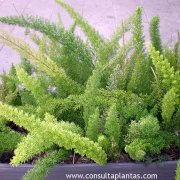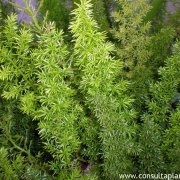Care of the plant Asparagus densiflorus or Asparagus Fern |
|
The genus Asparagus, family Asparagaceae, includes 400 species of herbaceous plants and climbing subshrubs native to Africa, Asia, the Mediterranean region, and Macaronesia. Some species are: Asparagus densiflorus, Asparagus setaceus, Asparagus falcatus, Asparagus officinalis, Asparagus virgatus, Asparagus asparagoides. Common names: Asparagus Fern, Plume asparagus, Foxtail Fern, Emerald Feather, Basket asparagus, Emerald Fern, Lace Fern, Plumosa Fern, Racemose Asparagus, Sprengeri Fern. This species is native to South Africa. They are herbaceous perennial hanging or creeping plants that reach 50 cm (1.64 feet) in height and 1 meter (3.28 feet) in diameter. The thin leaves are modified stems called cladodes. The small white flowers are not decorative. They bloom in summer. Ripe red fruits are quite decorative. Asparagus Fern is used on borders along walls, in light undergrowth and in hanging pots as terrace, indoor and greenhouse plants. Asparagus densiflorus prefers semi-shade exposure receiving direct sun in the early hours of the day. It does not resist temperatures below 7 ºC (44.6 ºF). The soil can be a mixture of equal parts coarse sand, leaf litter, and peat moss or regular garden soil. Transplant every year in early spring to renew the substrate. Water regularly (better with water without lime) so that the substrate is always slightly moist (never flood). In summer water 3 times a week and in winter only once a week. Fertilize every 20 days with mineral fertilizer during spring and summer. Prune dry or yellowed branches that disfigure the plant. Plume asparagus can be attacked by spider mites and mealybugs indoors if ventilation is poor or they suffer from drought. Basket asparagus is propagated by division in spring and from seeds sown in early spring (a slower process). |
Images of the plant Asparagus densiflorus or Asparagus Fern |
Find plants
Asparagus densiflorus or Asparagus Fern | Care and Growing
© 2026 FavThemes





